Culture Shock, International Business Structures and Globalisation
VerifiedAdded on 2022/12/28
|8
|1934
|41
Report
AI Summary
This report provides a comprehensive analysis of culture shock and its implications for international business, examining the challenges of operating in diverse cultural environments. It explores international division and product division structures, evaluating their advantages and disadvantages. The report delves into the concept of globalisation, identifying key contributing factors and illustrating its impact with examples. Furthermore, it discusses ethnocentric, polycentric, and geocentric frameworks within international HRM, highlighting their strategic approaches to managing human resources across different nations. Finally, it examines the characteristics of international and transitional strategies, providing insights into how businesses adapt to the complexities of the global market.
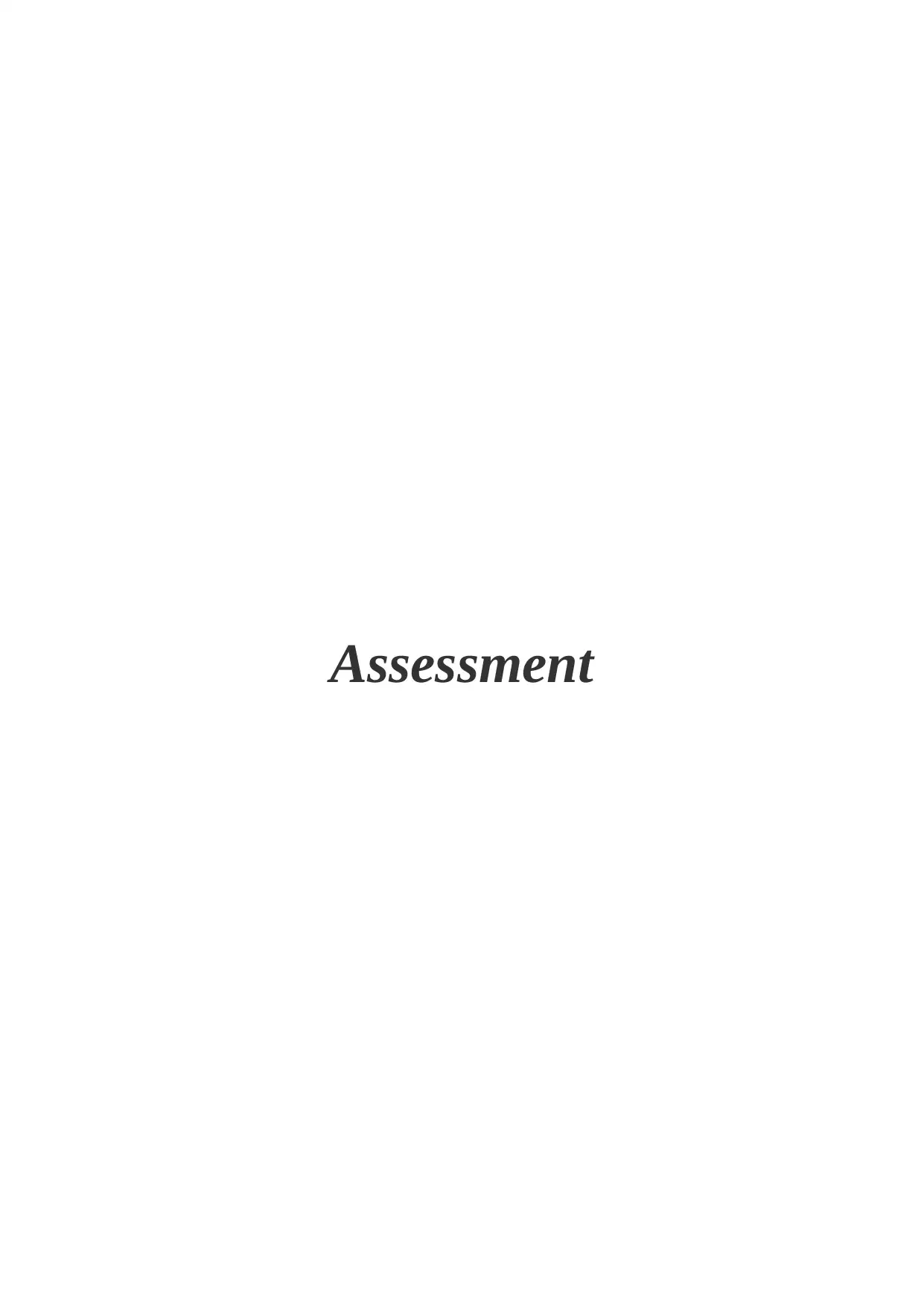
Assessment
Paraphrase This Document
Need a fresh take? Get an instant paraphrase of this document with our AI Paraphraser
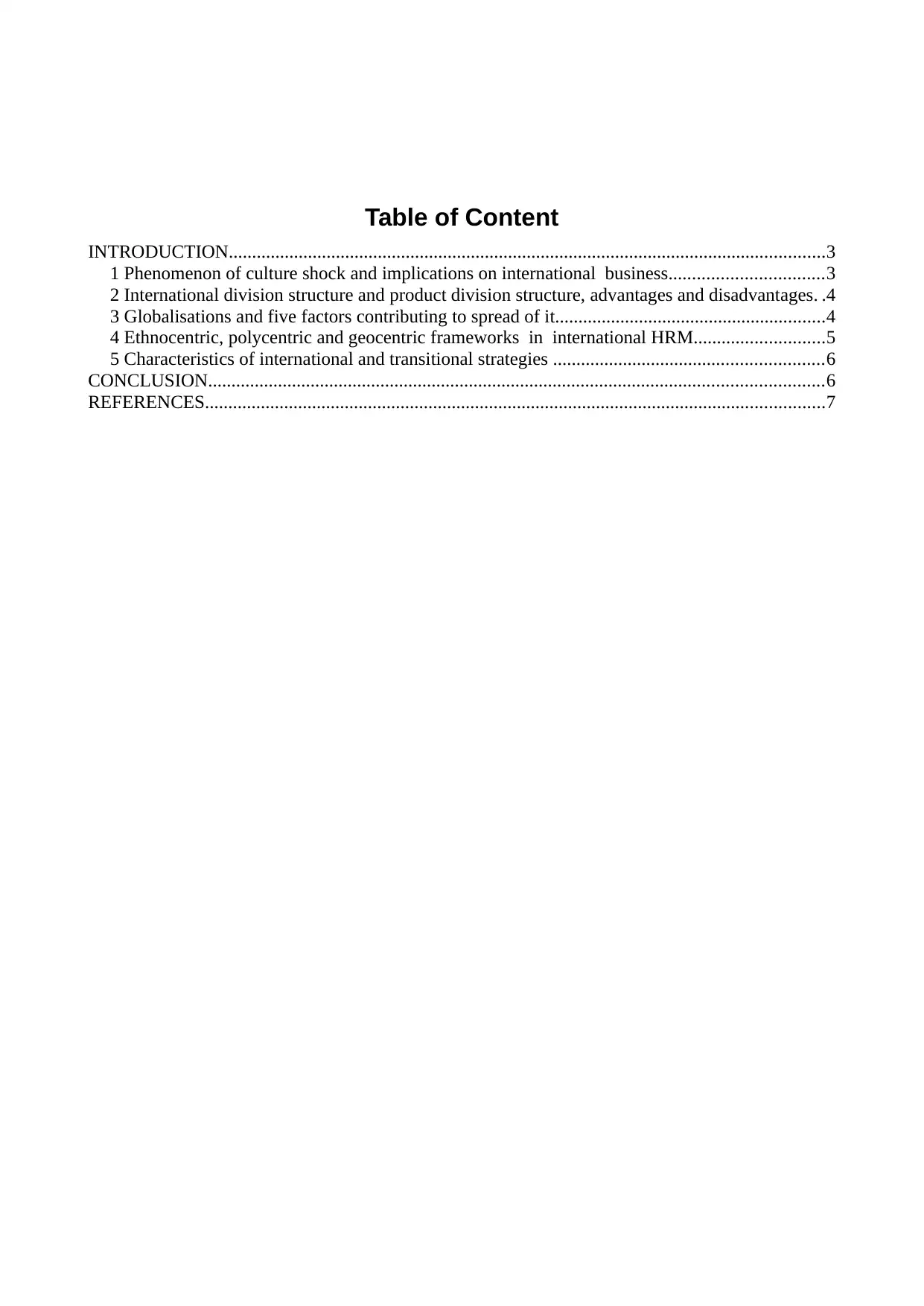
Table of Content
INTRODUCTION................................................................................................................................3
1 Phenomenon of culture shock and implications on international business.................................3
2 International division structure and product division structure, advantages and disadvantages. .4
3 Globalisations and five factors contributing to spread of it..........................................................4
4 Ethnocentric, polycentric and geocentric frameworks in international HRM............................5
5 Characteristics of international and transitional strategies ..........................................................6
CONCLUSION....................................................................................................................................6
REFERENCES.....................................................................................................................................7
INTRODUCTION................................................................................................................................3
1 Phenomenon of culture shock and implications on international business.................................3
2 International division structure and product division structure, advantages and disadvantages. .4
3 Globalisations and five factors contributing to spread of it..........................................................4
4 Ethnocentric, polycentric and geocentric frameworks in international HRM............................5
5 Characteristics of international and transitional strategies ..........................................................6
CONCLUSION....................................................................................................................................6
REFERENCES.....................................................................................................................................7
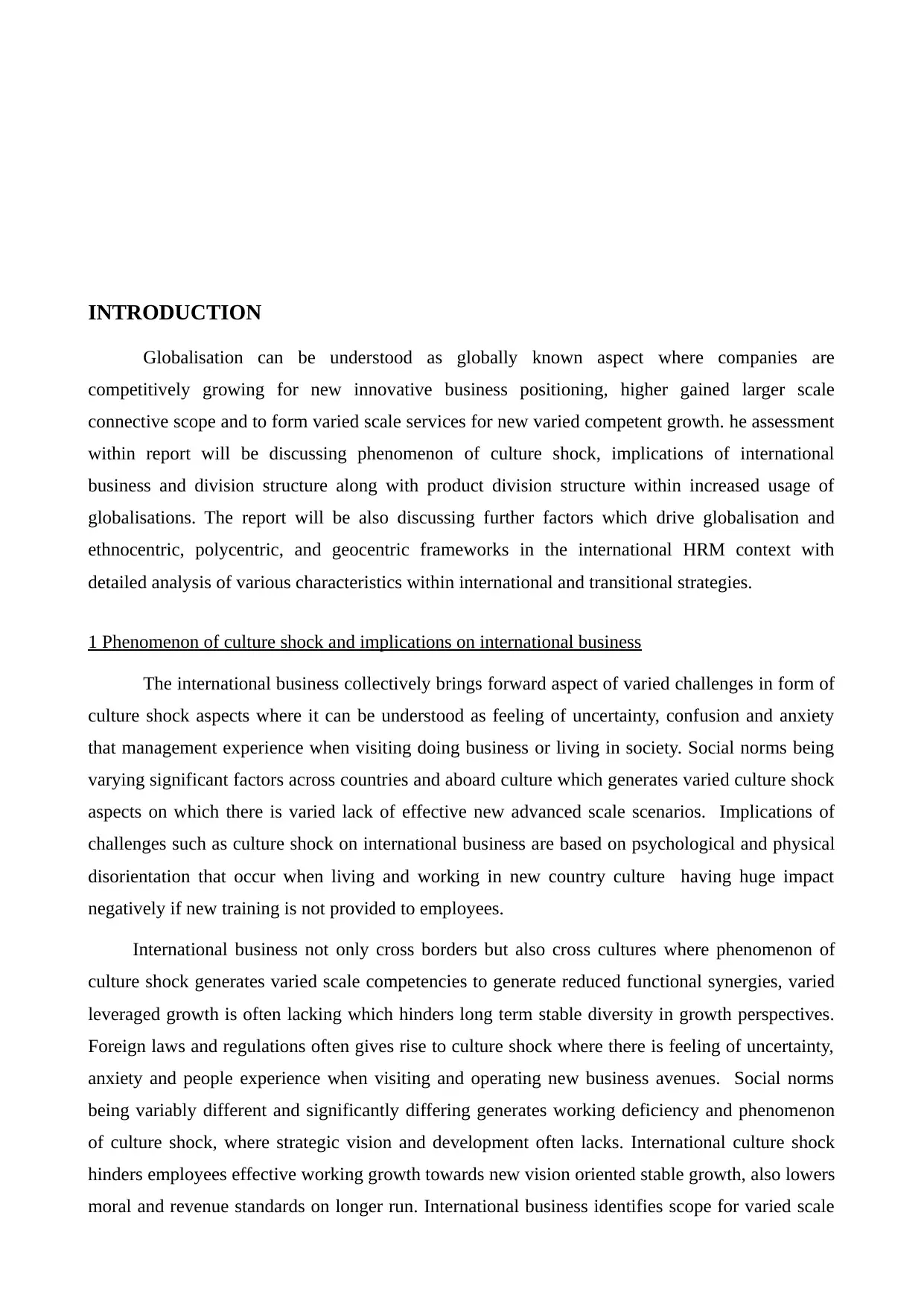
INTRODUCTION
Globalisation can be understood as globally known aspect where companies are
competitively growing for new innovative business positioning, higher gained larger scale
connective scope and to form varied scale services for new varied competent growth. he assessment
within report will be discussing phenomenon of culture shock, implications of international
business and division structure along with product division structure within increased usage of
globalisations. The report will be also discussing further factors which drive globalisation and
ethnocentric, polycentric, and geocentric frameworks in the international HRM context with
detailed analysis of various characteristics within international and transitional strategies.
1 Phenomenon of culture shock and implications on international business
The international business collectively brings forward aspect of varied challenges in form of
culture shock aspects where it can be understood as feeling of uncertainty, confusion and anxiety
that management experience when visiting doing business or living in society. Social norms being
varying significant factors across countries and aboard culture which generates varied culture shock
aspects on which there is varied lack of effective new advanced scale scenarios. Implications of
challenges such as culture shock on international business are based on psychological and physical
disorientation that occur when living and working in new country culture having huge impact
negatively if new training is not provided to employees.
International business not only cross borders but also cross cultures where phenomenon of
culture shock generates varied scale competencies to generate reduced functional synergies, varied
leveraged growth is often lacking which hinders long term stable diversity in growth perspectives.
Foreign laws and regulations often gives rise to culture shock where there is feeling of uncertainty,
anxiety and people experience when visiting and operating new business avenues. Social norms
being variably different and significantly differing generates working deficiency and phenomenon
of culture shock, where strategic vision and development often lacks. International culture shock
hinders employees effective working growth towards new vision oriented stable growth, also lowers
moral and revenue standards on longer run. International business identifies scope for varied scale
Globalisation can be understood as globally known aspect where companies are
competitively growing for new innovative business positioning, higher gained larger scale
connective scope and to form varied scale services for new varied competent growth. he assessment
within report will be discussing phenomenon of culture shock, implications of international
business and division structure along with product division structure within increased usage of
globalisations. The report will be also discussing further factors which drive globalisation and
ethnocentric, polycentric, and geocentric frameworks in the international HRM context with
detailed analysis of various characteristics within international and transitional strategies.
1 Phenomenon of culture shock and implications on international business
The international business collectively brings forward aspect of varied challenges in form of
culture shock aspects where it can be understood as feeling of uncertainty, confusion and anxiety
that management experience when visiting doing business or living in society. Social norms being
varying significant factors across countries and aboard culture which generates varied culture shock
aspects on which there is varied lack of effective new advanced scale scenarios. Implications of
challenges such as culture shock on international business are based on psychological and physical
disorientation that occur when living and working in new country culture having huge impact
negatively if new training is not provided to employees.
International business not only cross borders but also cross cultures where phenomenon of
culture shock generates varied scale competencies to generate reduced functional synergies, varied
leveraged growth is often lacking which hinders long term stable diversity in growth perspectives.
Foreign laws and regulations often gives rise to culture shock where there is feeling of uncertainty,
anxiety and people experience when visiting and operating new business avenues. Social norms
being variably different and significantly differing generates working deficiency and phenomenon
of culture shock, where strategic vision and development often lacks. International culture shock
hinders employees effective working growth towards new vision oriented stable growth, also lowers
moral and revenue standards on longer run. International business identifies scope for varied scale
⊘ This is a preview!⊘
Do you want full access?
Subscribe today to unlock all pages.

Trusted by 1+ million students worldwide
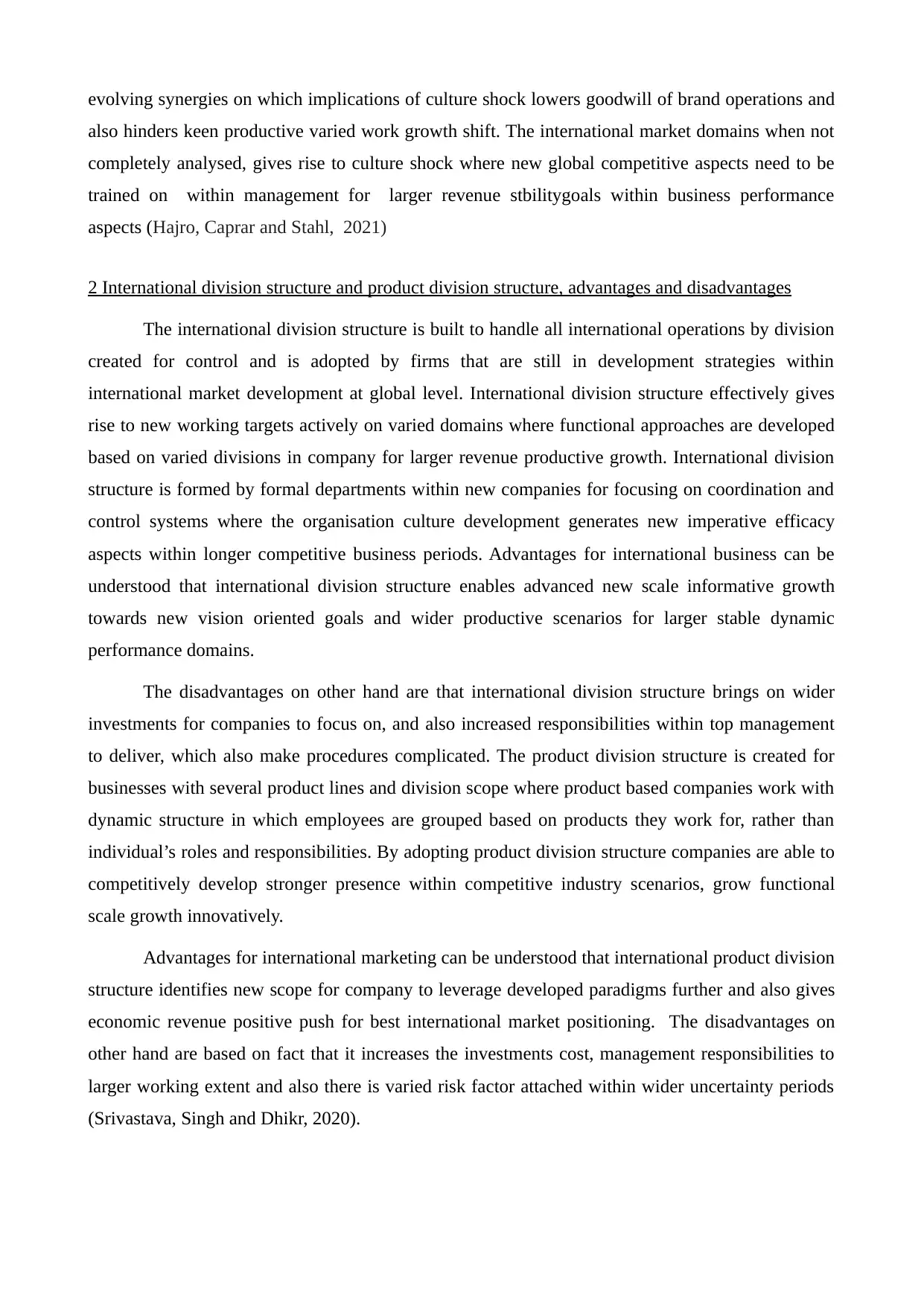
evolving synergies on which implications of culture shock lowers goodwill of brand operations and
also hinders keen productive varied work growth shift. The international market domains when not
completely analysed, gives rise to culture shock where new global competitive aspects need to be
trained on within management for larger revenue stbilitygoals within business performance
aspects (Hajro, Caprar and Stahl, 2021)
2 International division structure and product division structure, advantages and disadvantages
The international division structure is built to handle all international operations by division
created for control and is adopted by firms that are still in development strategies within
international market development at global level. International division structure effectively gives
rise to new working targets actively on varied domains where functional approaches are developed
based on varied divisions in company for larger revenue productive growth. International division
structure is formed by formal departments within new companies for focusing on coordination and
control systems where the organisation culture development generates new imperative efficacy
aspects within longer competitive business periods. Advantages for international business can be
understood that international division structure enables advanced new scale informative growth
towards new vision oriented goals and wider productive scenarios for larger stable dynamic
performance domains.
The disadvantages on other hand are that international division structure brings on wider
investments for companies to focus on, and also increased responsibilities within top management
to deliver, which also make procedures complicated. The product division structure is created for
businesses with several product lines and division scope where product based companies work with
dynamic structure in which employees are grouped based on products they work for, rather than
individual’s roles and responsibilities. By adopting product division structure companies are able to
competitively develop stronger presence within competitive industry scenarios, grow functional
scale growth innovatively.
Advantages for international marketing can be understood that international product division
structure identifies new scope for company to leverage developed paradigms further and also gives
economic revenue positive push for best international market positioning. The disadvantages on
other hand are based on fact that it increases the investments cost, management responsibilities to
larger working extent and also there is varied risk factor attached within wider uncertainty periods
(Srivastava, Singh and Dhikr, 2020).
also hinders keen productive varied work growth shift. The international market domains when not
completely analysed, gives rise to culture shock where new global competitive aspects need to be
trained on within management for larger revenue stbilitygoals within business performance
aspects (Hajro, Caprar and Stahl, 2021)
2 International division structure and product division structure, advantages and disadvantages
The international division structure is built to handle all international operations by division
created for control and is adopted by firms that are still in development strategies within
international market development at global level. International division structure effectively gives
rise to new working targets actively on varied domains where functional approaches are developed
based on varied divisions in company for larger revenue productive growth. International division
structure is formed by formal departments within new companies for focusing on coordination and
control systems where the organisation culture development generates new imperative efficacy
aspects within longer competitive business periods. Advantages for international business can be
understood that international division structure enables advanced new scale informative growth
towards new vision oriented goals and wider productive scenarios for larger stable dynamic
performance domains.
The disadvantages on other hand are that international division structure brings on wider
investments for companies to focus on, and also increased responsibilities within top management
to deliver, which also make procedures complicated. The product division structure is created for
businesses with several product lines and division scope where product based companies work with
dynamic structure in which employees are grouped based on products they work for, rather than
individual’s roles and responsibilities. By adopting product division structure companies are able to
competitively develop stronger presence within competitive industry scenarios, grow functional
scale growth innovatively.
Advantages for international marketing can be understood that international product division
structure identifies new scope for company to leverage developed paradigms further and also gives
economic revenue positive push for best international market positioning. The disadvantages on
other hand are based on fact that it increases the investments cost, management responsibilities to
larger working extent and also there is varied risk factor attached within wider uncertainty periods
(Srivastava, Singh and Dhikr, 2020).
Paraphrase This Document
Need a fresh take? Get an instant paraphrase of this document with our AI Paraphraser
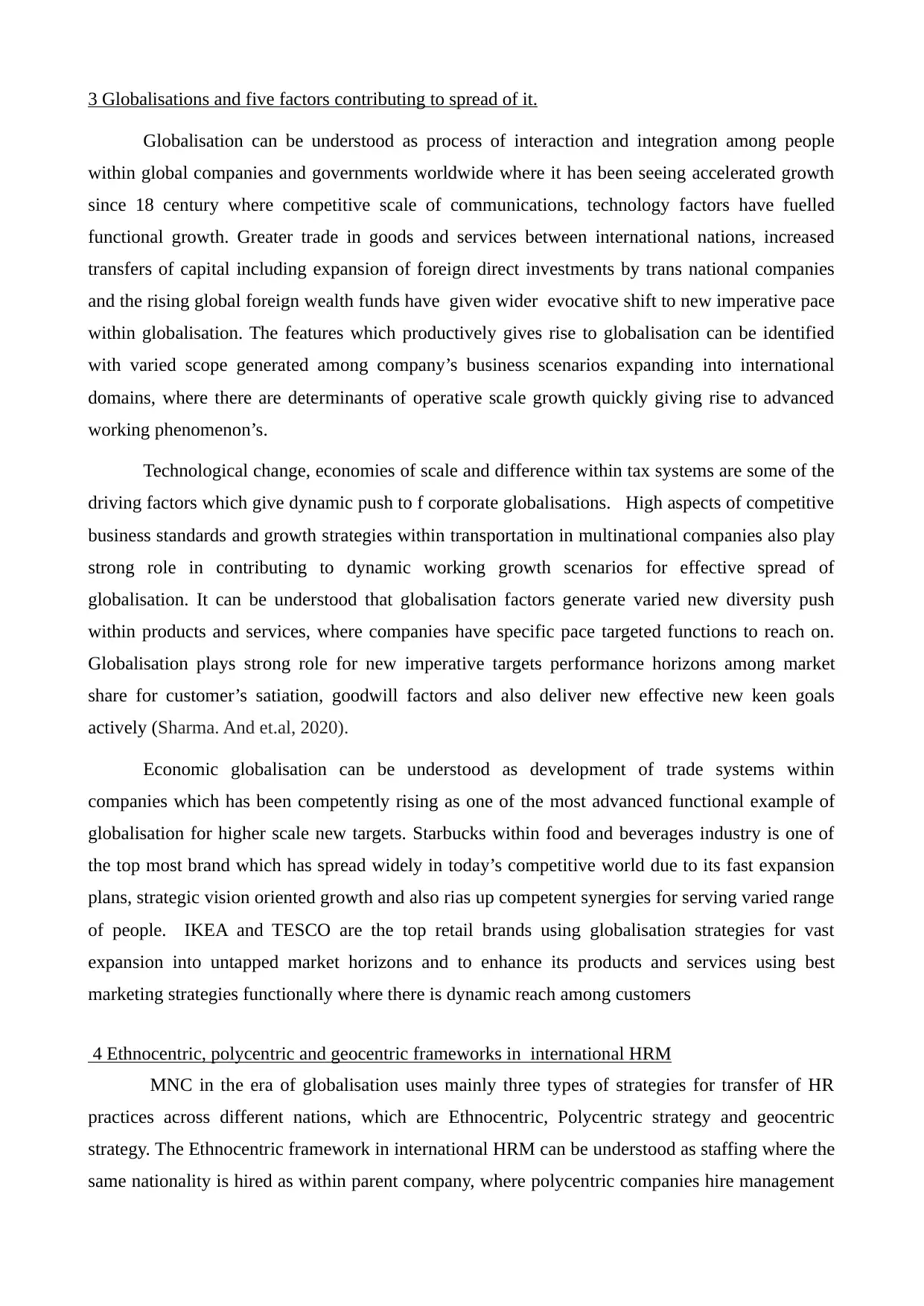
3 Globalisations and five factors contributing to spread of it.
Globalisation can be understood as process of interaction and integration among people
within global companies and governments worldwide where it has been seeing accelerated growth
since 18 century where competitive scale of communications, technology factors have fuelled
functional growth. Greater trade in goods and services between international nations, increased
transfers of capital including expansion of foreign direct investments by trans national companies
and the rising global foreign wealth funds have given wider evocative shift to new imperative pace
within globalisation. The features which productively gives rise to globalisation can be identified
with varied scope generated among company’s business scenarios expanding into international
domains, where there are determinants of operative scale growth quickly giving rise to advanced
working phenomenon’s.
Technological change, economies of scale and difference within tax systems are some of the
driving factors which give dynamic push to f corporate globalisations. High aspects of competitive
business standards and growth strategies within transportation in multinational companies also play
strong role in contributing to dynamic working growth scenarios for effective spread of
globalisation. It can be understood that globalisation factors generate varied new diversity push
within products and services, where companies have specific pace targeted functions to reach on.
Globalisation plays strong role for new imperative targets performance horizons among market
share for customer’s satiation, goodwill factors and also deliver new effective new keen goals
actively (Sharma. And et.al, 2020).
Economic globalisation can be understood as development of trade systems within
companies which has been competently rising as one of the most advanced functional example of
globalisation for higher scale new targets. Starbucks within food and beverages industry is one of
the top most brand which has spread widely in today’s competitive world due to its fast expansion
plans, strategic vision oriented growth and also rias up competent synergies for serving varied range
of people. IKEA and TESCO are the top retail brands using globalisation strategies for vast
expansion into untapped market horizons and to enhance its products and services using best
marketing strategies functionally where there is dynamic reach among customers
4 Ethnocentric, polycentric and geocentric frameworks in international HRM
MNC in the era of globalisation uses mainly three types of strategies for transfer of HR
practices across different nations, which are Ethnocentric, Polycentric strategy and geocentric
strategy. The Ethnocentric framework in international HRM can be understood as staffing where the
same nationality is hired as within parent company, where polycentric companies hire management
Globalisation can be understood as process of interaction and integration among people
within global companies and governments worldwide where it has been seeing accelerated growth
since 18 century where competitive scale of communications, technology factors have fuelled
functional growth. Greater trade in goods and services between international nations, increased
transfers of capital including expansion of foreign direct investments by trans national companies
and the rising global foreign wealth funds have given wider evocative shift to new imperative pace
within globalisation. The features which productively gives rise to globalisation can be identified
with varied scope generated among company’s business scenarios expanding into international
domains, where there are determinants of operative scale growth quickly giving rise to advanced
working phenomenon’s.
Technological change, economies of scale and difference within tax systems are some of the
driving factors which give dynamic push to f corporate globalisations. High aspects of competitive
business standards and growth strategies within transportation in multinational companies also play
strong role in contributing to dynamic working growth scenarios for effective spread of
globalisation. It can be understood that globalisation factors generate varied new diversity push
within products and services, where companies have specific pace targeted functions to reach on.
Globalisation plays strong role for new imperative targets performance horizons among market
share for customer’s satiation, goodwill factors and also deliver new effective new keen goals
actively (Sharma. And et.al, 2020).
Economic globalisation can be understood as development of trade systems within
companies which has been competently rising as one of the most advanced functional example of
globalisation for higher scale new targets. Starbucks within food and beverages industry is one of
the top most brand which has spread widely in today’s competitive world due to its fast expansion
plans, strategic vision oriented growth and also rias up competent synergies for serving varied range
of people. IKEA and TESCO are the top retail brands using globalisation strategies for vast
expansion into untapped market horizons and to enhance its products and services using best
marketing strategies functionally where there is dynamic reach among customers
4 Ethnocentric, polycentric and geocentric frameworks in international HRM
MNC in the era of globalisation uses mainly three types of strategies for transfer of HR
practices across different nations, which are Ethnocentric, Polycentric strategy and geocentric
strategy. The Ethnocentric framework in international HRM can be understood as staffing where the
same nationality is hired as within parent company, where polycentric companies hire management
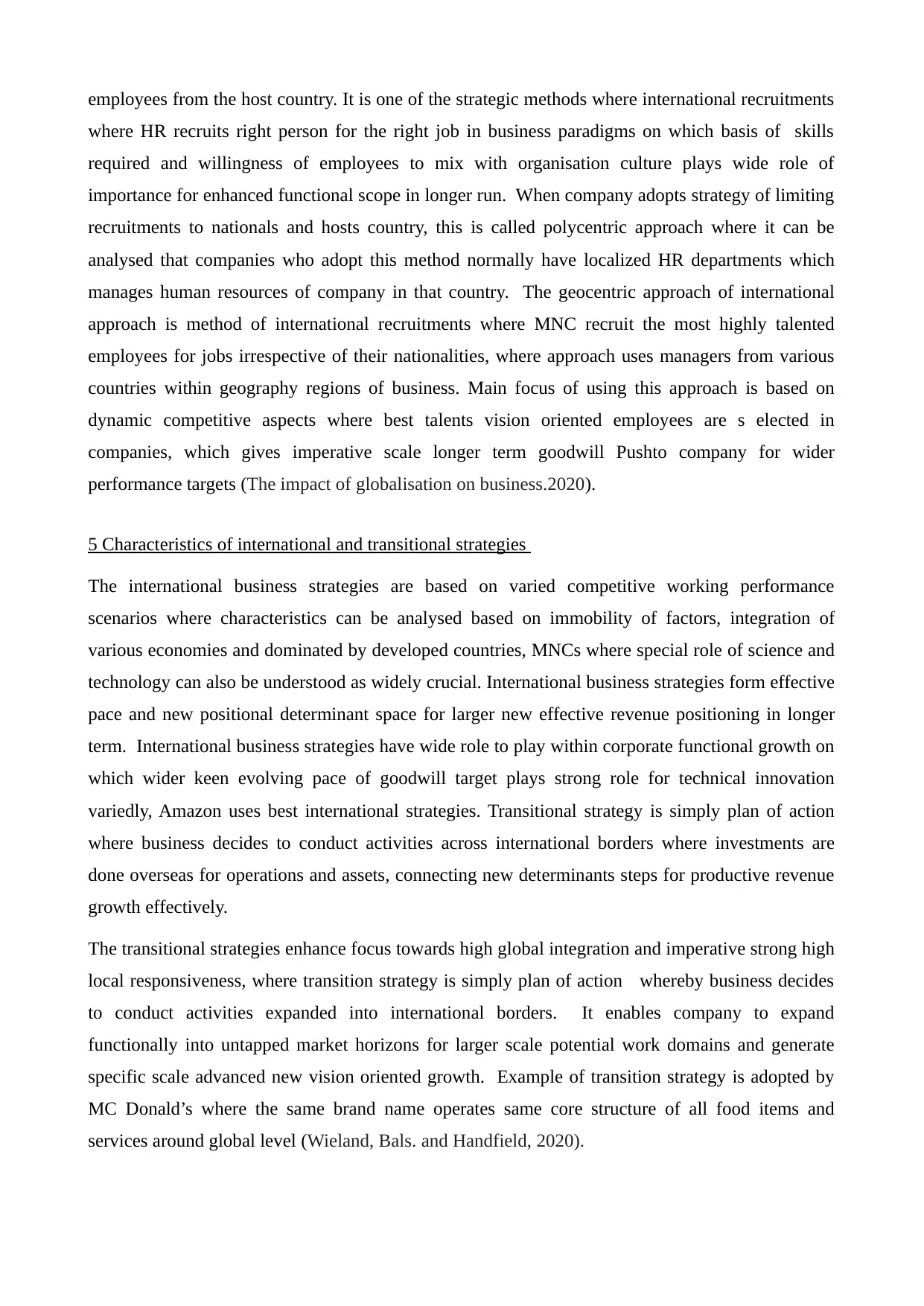
employees from the host country. It is one of the strategic methods where international recruitments
where HR recruits right person for the right job in business paradigms on which basis of skills
required and willingness of employees to mix with organisation culture plays wide role of
importance for enhanced functional scope in longer run. When company adopts strategy of limiting
recruitments to nationals and hosts country, this is called polycentric approach where it can be
analysed that companies who adopt this method normally have localized HR departments which
manages human resources of company in that country. The geocentric approach of international
approach is method of international recruitments where MNC recruit the most highly talented
employees for jobs irrespective of their nationalities, where approach uses managers from various
countries within geography regions of business. Main focus of using this approach is based on
dynamic competitive aspects where best talents vision oriented employees are s elected in
companies, which gives imperative scale longer term goodwill Pushto company for wider
performance targets (The impact of globalisation on business.2020).
5 Characteristics of international and transitional strategies
The international business strategies are based on varied competitive working performance
scenarios where characteristics can be analysed based on immobility of factors, integration of
various economies and dominated by developed countries, MNCs where special role of science and
technology can also be understood as widely crucial. International business strategies form effective
pace and new positional determinant space for larger new effective revenue positioning in longer
term. International business strategies have wide role to play within corporate functional growth on
which wider keen evolving pace of goodwill target plays strong role for technical innovation
variedly, Amazon uses best international strategies. Transitional strategy is simply plan of action
where business decides to conduct activities across international borders where investments are
done overseas for operations and assets, connecting new determinants steps for productive revenue
growth effectively.
The transitional strategies enhance focus towards high global integration and imperative strong high
local responsiveness, where transition strategy is simply plan of action whereby business decides
to conduct activities expanded into international borders. It enables company to expand
functionally into untapped market horizons for larger scale potential work domains and generate
specific scale advanced new vision oriented growth. Example of transition strategy is adopted by
MC Donald’s where the same brand name operates same core structure of all food items and
services around global level (Wieland, Bals. and Handfield, 2020).
where HR recruits right person for the right job in business paradigms on which basis of skills
required and willingness of employees to mix with organisation culture plays wide role of
importance for enhanced functional scope in longer run. When company adopts strategy of limiting
recruitments to nationals and hosts country, this is called polycentric approach where it can be
analysed that companies who adopt this method normally have localized HR departments which
manages human resources of company in that country. The geocentric approach of international
approach is method of international recruitments where MNC recruit the most highly talented
employees for jobs irrespective of their nationalities, where approach uses managers from various
countries within geography regions of business. Main focus of using this approach is based on
dynamic competitive aspects where best talents vision oriented employees are s elected in
companies, which gives imperative scale longer term goodwill Pushto company for wider
performance targets (The impact of globalisation on business.2020).
5 Characteristics of international and transitional strategies
The international business strategies are based on varied competitive working performance
scenarios where characteristics can be analysed based on immobility of factors, integration of
various economies and dominated by developed countries, MNCs where special role of science and
technology can also be understood as widely crucial. International business strategies form effective
pace and new positional determinant space for larger new effective revenue positioning in longer
term. International business strategies have wide role to play within corporate functional growth on
which wider keen evolving pace of goodwill target plays strong role for technical innovation
variedly, Amazon uses best international strategies. Transitional strategy is simply plan of action
where business decides to conduct activities across international borders where investments are
done overseas for operations and assets, connecting new determinants steps for productive revenue
growth effectively.
The transitional strategies enhance focus towards high global integration and imperative strong high
local responsiveness, where transition strategy is simply plan of action whereby business decides
to conduct activities expanded into international borders. It enables company to expand
functionally into untapped market horizons for larger scale potential work domains and generate
specific scale advanced new vision oriented growth. Example of transition strategy is adopted by
MC Donald’s where the same brand name operates same core structure of all food items and
services around global level (Wieland, Bals. and Handfield, 2020).
⊘ This is a preview!⊘
Do you want full access?
Subscribe today to unlock all pages.

Trusted by 1+ million students worldwide
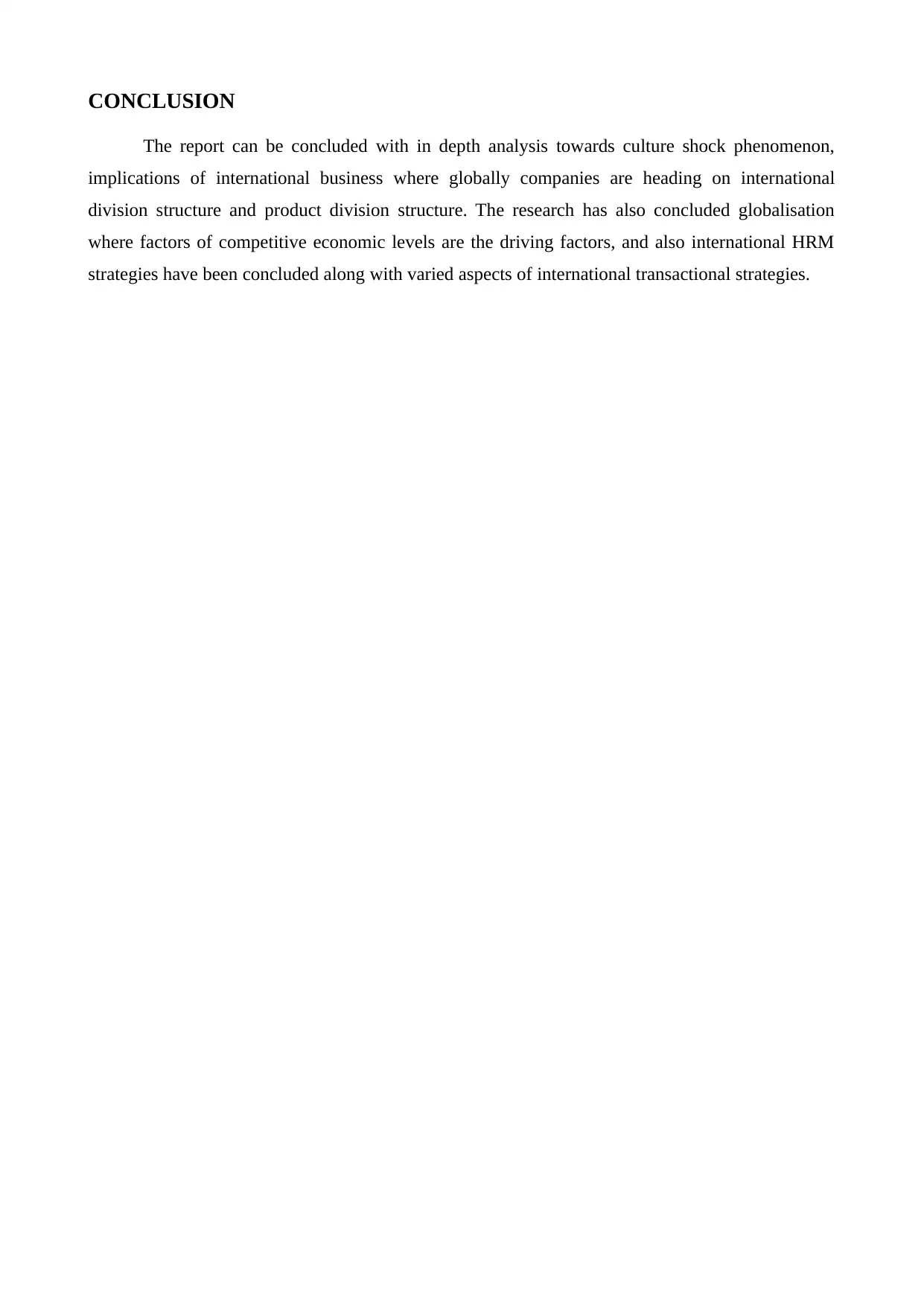
CONCLUSION
The report can be concluded with in depth analysis towards culture shock phenomenon,
implications of international business where globally companies are heading on international
division structure and product division structure. The research has also concluded globalisation
where factors of competitive economic levels are the driving factors, and also international HRM
strategies have been concluded along with varied aspects of international transactional strategies.
The report can be concluded with in depth analysis towards culture shock phenomenon,
implications of international business where globally companies are heading on international
division structure and product division structure. The research has also concluded globalisation
where factors of competitive economic levels are the driving factors, and also international HRM
strategies have been concluded along with varied aspects of international transactional strategies.
Paraphrase This Document
Need a fresh take? Get an instant paraphrase of this document with our AI Paraphraser
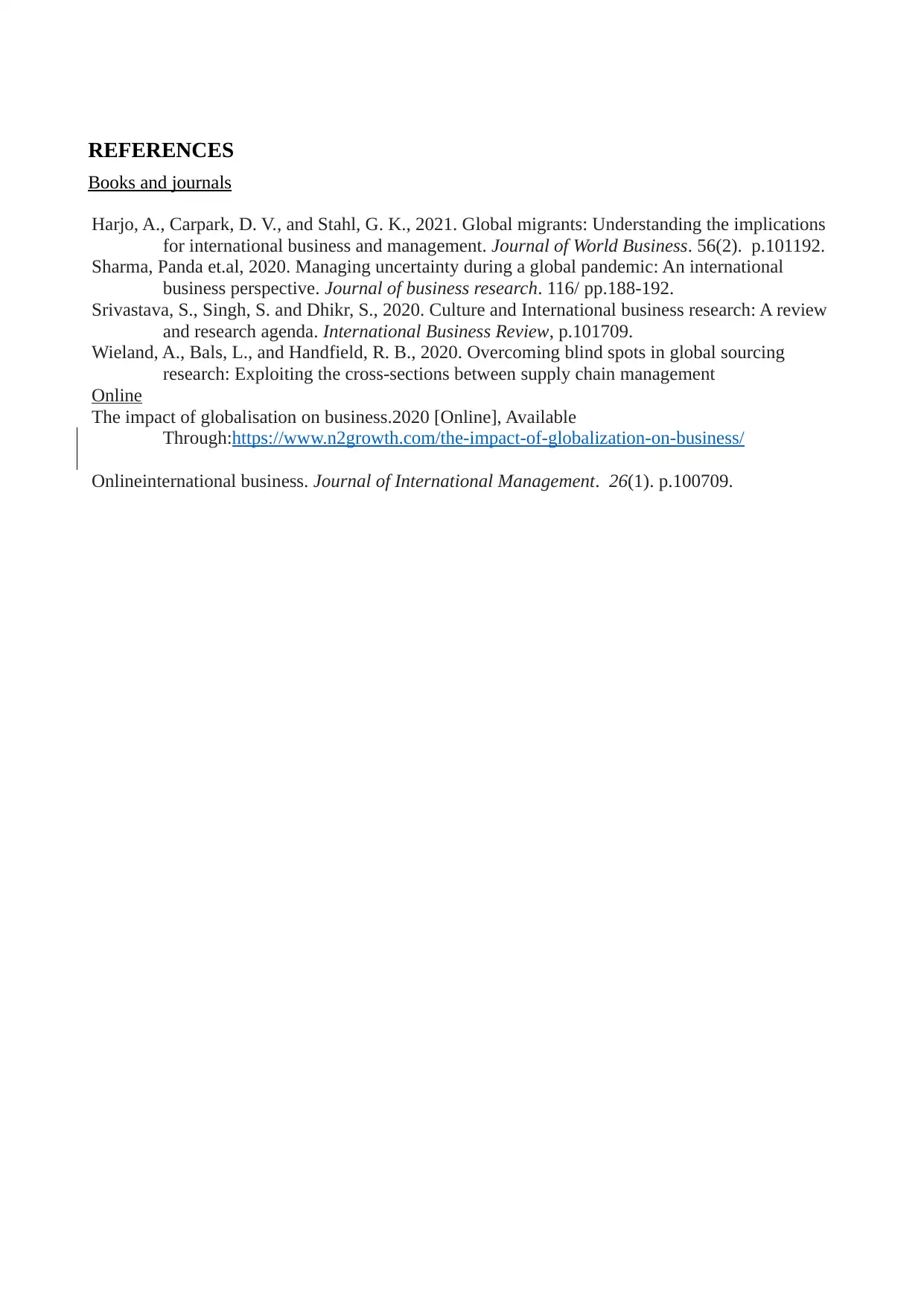
REFERENCES
Books and journals
Harjo, A., Carpark, D. V., and Stahl, G. K., 2021. Global migrants: Understanding the implications
for international business and management. Journal of World Business. 56(2). p.101192.
Sharma, Panda et.al, 2020. Managing uncertainty during a global pandemic: An international
business perspective. Journal of business research. 116/ pp.188-192.
Srivastava, S., Singh, S. and Dhikr, S., 2020. Culture and International business research: A review
and research agenda. International Business Review, p.101709.
Wieland, A., Bals, L., and Handfield, R. B., 2020. Overcoming blind spots in global sourcing
research: Exploiting the cross-sections between supply chain management
Online
The impact of globalisation on business.2020 [Online], Available
Through:https://www.n2growth.com/the-impact-of-globalization-on-business/
Onlineinternational business. Journal of International Management. 26(1). p.100709.
Books and journals
Harjo, A., Carpark, D. V., and Stahl, G. K., 2021. Global migrants: Understanding the implications
for international business and management. Journal of World Business. 56(2). p.101192.
Sharma, Panda et.al, 2020. Managing uncertainty during a global pandemic: An international
business perspective. Journal of business research. 116/ pp.188-192.
Srivastava, S., Singh, S. and Dhikr, S., 2020. Culture and International business research: A review
and research agenda. International Business Review, p.101709.
Wieland, A., Bals, L., and Handfield, R. B., 2020. Overcoming blind spots in global sourcing
research: Exploiting the cross-sections between supply chain management
Online
The impact of globalisation on business.2020 [Online], Available
Through:https://www.n2growth.com/the-impact-of-globalization-on-business/
Onlineinternational business. Journal of International Management. 26(1). p.100709.
1 out of 8
Related Documents
Your All-in-One AI-Powered Toolkit for Academic Success.
+13062052269
info@desklib.com
Available 24*7 on WhatsApp / Email
![[object Object]](/_next/static/media/star-bottom.7253800d.svg)
Unlock your academic potential
Copyright © 2020–2025 A2Z Services. All Rights Reserved. Developed and managed by ZUCOL.





